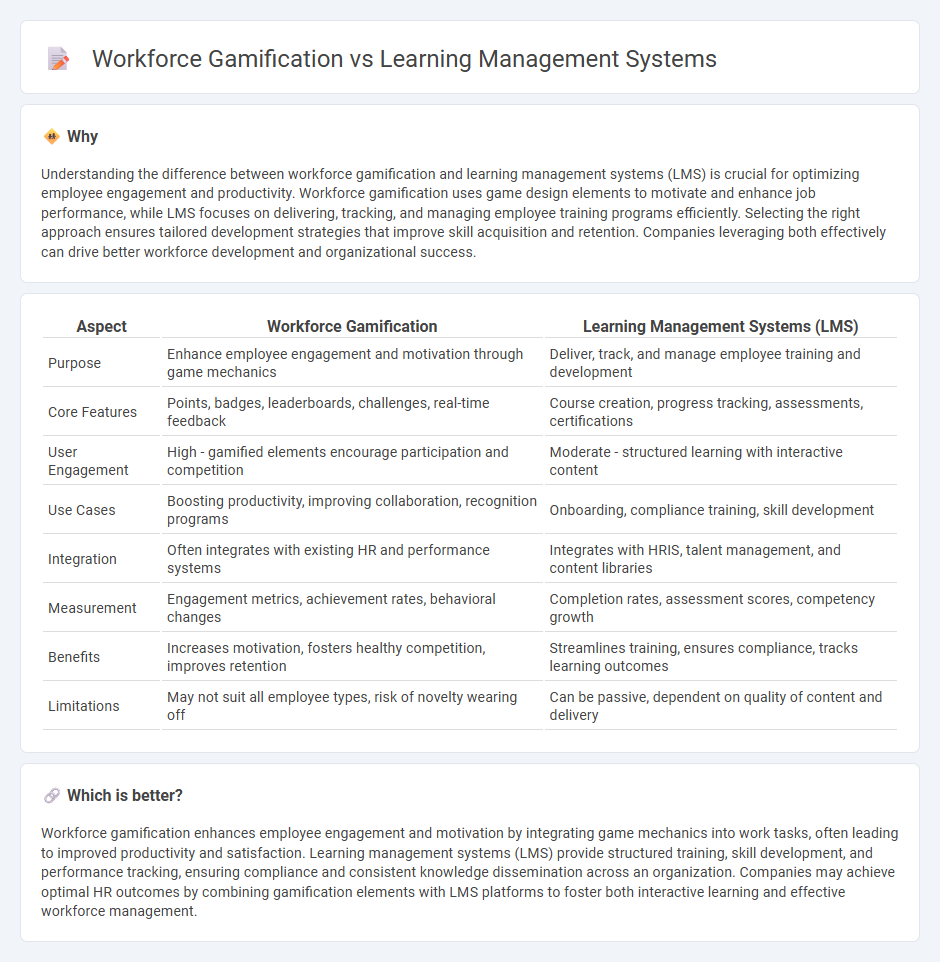
Workforce gamification enhances employee engagement by incorporating game elements into tasks, boosting motivation and productivity. Learning management systems (LMS) provide structured training platforms that track progress and deliver educational content efficiently. Explore the benefits of integrating gamification with LMS to transform your workforce development strategy.
Why it is important
Understanding the difference between workforce gamification and learning management systems (LMS) is crucial for optimizing employee engagement and productivity. Workforce gamification uses game design elements to motivate and enhance job performance, while LMS focuses on delivering, tracking, and managing employee training programs efficiently. Selecting the right approach ensures tailored development strategies that improve skill acquisition and retention. Companies leveraging both effectively can drive better workforce development and organizational success.
Comparison Table
| Aspect | Workforce Gamification | Learning Management Systems (LMS) |
|---|---|---|
| Purpose | Enhance employee engagement and motivation through game mechanics | Deliver, track, and manage employee training and development |
| Core Features | Points, badges, leaderboards, challenges, real-time feedback | Course creation, progress tracking, assessments, certifications |
| User Engagement | High - gamified elements encourage participation and competition | Moderate - structured learning with interactive content |
| Use Cases | Boosting productivity, improving collaboration, recognition programs | Onboarding, compliance training, skill development |
| Integration | Often integrates with existing HR and performance systems | Integrates with HRIS, talent management, and content libraries |
| Measurement | Engagement metrics, achievement rates, behavioral changes | Completion rates, assessment scores, competency growth |
| Benefits | Increases motivation, fosters healthy competition, improves retention | Streamlines training, ensures compliance, tracks learning outcomes |
| Limitations | May not suit all employee types, risk of novelty wearing off | Can be passive, dependent on quality of content and delivery |
Which is better?
Workforce gamification enhances employee engagement and motivation by integrating game mechanics into work tasks, often leading to improved productivity and satisfaction. Learning management systems (LMS) provide structured training, skill development, and performance tracking, ensuring compliance and consistent knowledge dissemination across an organization. Companies may achieve optimal HR outcomes by combining gamification elements with LMS platforms to foster both interactive learning and effective workforce management.
Connection
Workforce gamification integrates game mechanics into Learning Management Systems (LMS) to boost employee engagement and training effectiveness. By incorporating elements such as leaderboards, badges, and points into LMS platforms, organizations enhance motivation and reinforce skill development. This connection drives improved knowledge retention, performance tracking, and fosters a competitive yet collaborative learning environment in Human Resources.
Key Terms
Training Modules
Training modules in learning management systems (LMS) provide structured, scalable content delivery designed to enhance employee skills and compliance through assessments and progress tracking. Workforce gamification integrates game mechanics with training modules to boost engagement, motivation, and knowledge retention by leveraging rewards, leaderboards, and interactive challenges. Explore how combining LMS with gamification can transform your corporate training strategy and elevate workforce performance.
Performance Metrics
Learning management systems (LMS) track employee progress through detailed performance metrics such as course completion rates, assessment scores, and skill development, providing a structured view of learning outcomes. Workforce gamification enhances motivation and engagement by integrating game mechanics into tasks, using real-time feedback and rewards to improve performance metrics like productivity, accuracy, and collaboration. Explore how combining LMS and gamification strategies can optimize workforce performance and drive measurable results.
Employee Engagement
Learning management systems (LMS) provide structured training and performance tracking to enhance employee skills, while workforce gamification leverages game mechanics to boost motivation and participation in job tasks. Both approaches aim to improve employee engagement by creating interactive and rewarding environments that foster continuous learning and productivity. Explore how integrating LMS with gamification strategies can transform your organization's employee engagement levels.
Source and External Links
Learning Management System - A learning management system is a software application used for the administration, documentation, tracking, and delivery of educational content.
Learning Management System - An LMS is a software application used to plan, implement, and assess specific learning processes, often utilized by educational institutions and businesses.
Learning Management System Software - Canvas LMS serves as a central hub for managing online learning materials and interactions, offering features for content delivery and student-educator communication.
 dowidth.com
dowidth.com